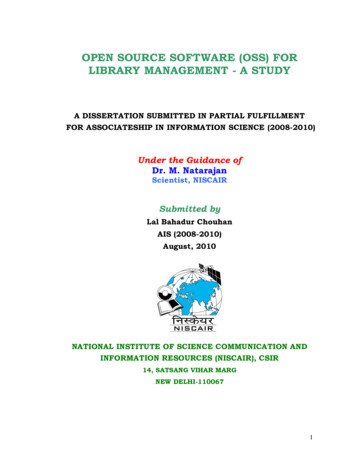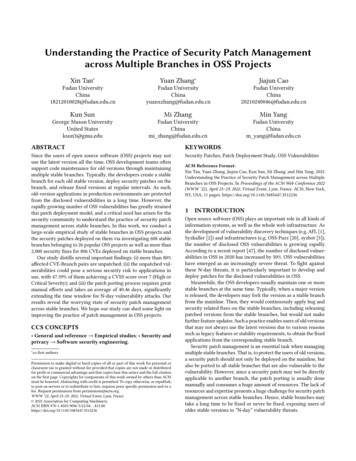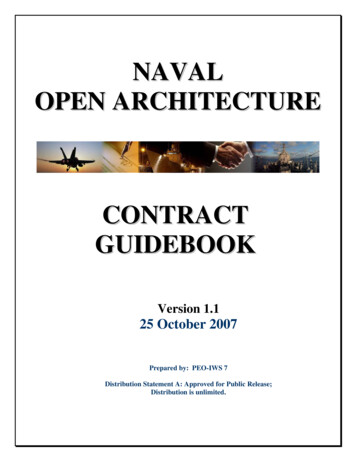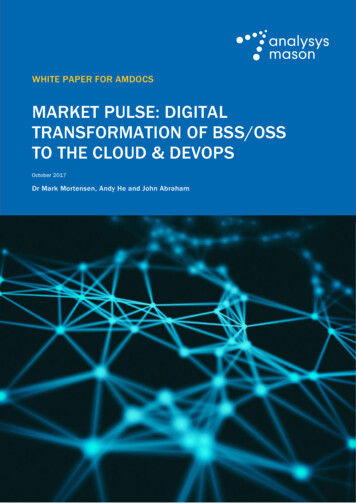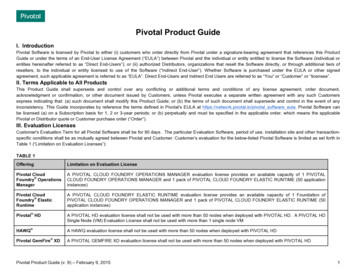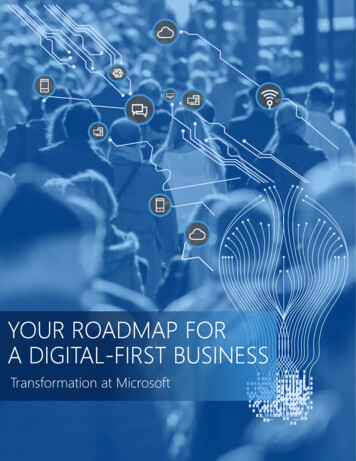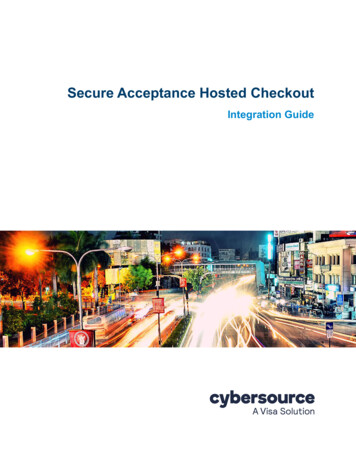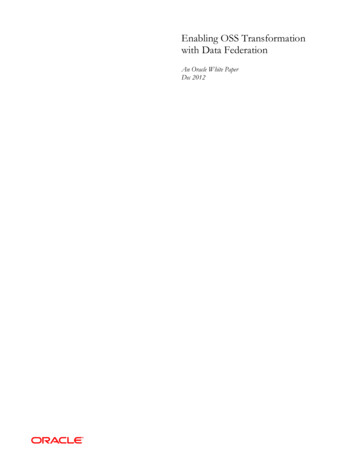
Transcription
Enabling OSS Transformationwith Data FederationAn Oracle White PaperDec 2012
Enabling OSS Transformation with Data FederationIntroduction . 3Leverage Existing Investments for OSS Transformation . 4UIM Data Federation Reference Models . 7Unify Service Fulfillment through Data Federation . 7Reference Model: UIM as Service Inventory . 8Unify Service Fulfillment through Connectivity Co-operation. 9Reference Model: UIM as Service Inventory . 9Extend Capabilities of Existing Service Fulfillment Solution . 10Reference Model: UIM as Resource Inventory . 10Data Federation Considerations. 11Conclusion . 12Enabling OSS Transformation with Data FederationPage 2
Enabling OSS Transformation with Data FederationMany Communications Service Providers (CSPs) are struggling with the harsh realitythat their inventory data is spread across several standalone inventory silos that havegrown from historical, business, and political reasons. The lack of unified view ofinventory data impacts revenues and increases the OPEX for a CSP. Sometimes, themigration cost from multiple legacy systems to a single next-gen inventory system is sohigh that it does not make business sense to replace everything. This leaves the CSPsin a difficult situation and they find it hard to scale up their business according to themarket demand. CSPs need a winning Inventory Management System that can'federate' with their existing legacy systems and provide the unified view of theirinventory to enable them in taking better informed decisions about their business.CSPs realize this and they are showing increased interest in Federation. Reports fromvarious analysts like Analyst Mason, Gartner and Stratecast have emphasized theneed for a federated environment where CSPs can get a unified and comprehensive viewof their complete inventory.Oracle Communications Unified Inventory Management (UIM) provides aframework that can federate and co-operate with multiple legacy inventory systems,providing a unified and comprehensive view of the inventory managed in those systems.It also allows the CSPs to roll out the next-gen services over their existing legacynetwork with reduced time-to-market with minimum investments. UIM DataFederation Framework enables the CSPs to stay ahead of their competition byenabling them to deliver next-gen services to bigger subscriber base with reducedCAPEX and OPEX.“CSPs are federating the product, serviceINTRODUCTIONand network data that is required inMost CSPs are faced with complex OSS system architectures that have evolvedover time. They were built by a variety of business groups such as IT departmentsand system integrators. In addition, some of these systems have been designed tosupport an organizational alignment on a particular service, or have evolvedthrough growth and acquisition. As a result, service and resource information ismanaged across disparate systems and databases. Because of these considerations,introducing new communications technologies, services, or even businessprocesses is full of challenges and risks.multiple stacks using specialized productsand ITIL master data managementtechniques, rather than replacing all of thestacks in a large transformation project.Federation often crosses the OSS/BSSboundary.”—Service Fulfilment Systems:Worldwide Market Shares, 2011, AnalysisMasonThree paths to upgrading OSS applications are typically discussed: Enhancing legacy OSS applications to support new requirementsEnabling OSS Transformation with Data FederationPage 3
Deploying new silo applications to address new requirements Replacing outdated OSS applications with modern systems designed tomanage traditional and next-generation services and resourcesThe first path faces high cost and risk associated with trying to adapt antiquatedsoftware to new purposes it wasn’t designed for. Chances are that it won’t meet thetime-to-market requirements of today’s CSP. The second path compounds theproblem by introducing more disparate databases and fragmentation in the backoffice. Deploying a new OSS to manage traditional and next-generationrequirements is an appropriate long-term solution, but this is a multi-year projectbecause of the costs and risks associated with data migration and business processredefinition.The economic reality of today’s back office calls for approaches that enable CSPsto leverage their investments in legacy applications when appropriate while alsointroducing new offerings in a cooperative fashion. This is the best of both worlds,because it enables controlled, orderly modernization of the OSS while alsoaddressing key time-to-market needs.CSPs have three choices for rolling out newservice offerings in the back office—enhance legacy OSS applications to supportnew requirements, deploy new siloapplications to address new requirements,or displace outdated OSS applications witha modern OSS designed to managetraditional and next-generation services andresources.LEVERAGE EXISTING INVESTMENTS FOR OSS TRANSFORMATIONOne of Oracle Communications’ key strategies to address this lingering problem isto support the cooperation of OSS systems with legacy systems through datafederation. Data federation is a viable and often necessary approach for OSStransformation projects over wholesale system replacement approaches. Datafederation enables disparate systems to cooperate in solving end-to-end businessproblems while presenting a common user experience. In a data federationarrangement, specific data access and data management tasks and processes aredelegated transparently to legacy systems.Data federation is not a new concept. It has been utilized in business intelligenceapplications for some time. These applications have built-in features designeddirectly that enables data to be served from disparate sources into common viewsfor reporting and analysis.Data federation in the business intelligence space, while not trivial, is morestraightforward than data federation to the OSS space. Here, new challenges areintroduced for bi-directional integrity, synchronization, and performance. Thesechallenges arise from the need to support Online Transaction Processing (OLTP)involving federated data. In an OLTP environment, there is a need for real-timecooperation between systems where data can be referenced, shared, andsynchronized.The user experience should hide many of the complexities of this cooperation andpresent a common user experience to the user. In many cases, users have no needto know that a business process involves multiple systems and databases.Enabling OSS Transformation with Data FederationPage 4
UIM’s model is founded on TeleManagementForum Information Framework (SID). SIDenables specialized deployments for nicheservices or full-scale inventorytransformation projects. This flexiblearchitecture enables data federation.UIM has been designed to enable data federation; it does not assume it is the onlyinventory system in the provider’s environment. UIM enables a customer- andservice-aware inventory that includes physical and logical views of networkconfigurations and resources. UIM can represent subscribers, services, andresources in its database while cooperating with interdependent application datasources through data federation. UIM’s modular architecture is based oncontemporary Java technologies and open Service Oriented Architecture (SOA)standards.Data federation with UIM delivers the following advantages over traditional systemdeployments: Improved time-to-market because of the reuse of existing systems andprocesses Transparency of underlying systems Ability of native systems to perform resource operations, such as queries Risk reduction because massive data migration is not required Data unification across multiple inventoriesUsing standard approaches and implementation models, CSPs can design styles ofdata federation that are appropriate for their specific business purposes to improvetime-to-market for new services and technologies. In one common federationmodel, two inventory systems partition the data among themselves based onseparating the service management function from resource management. Forexample, new resources can be managed in UIM while cooperating with legacy OSSapplications managing traditional resources, all the while participating in a commonservice configuration.As an example, consider a CSP that needs to implement a new MPLS VPN servicesoffering over a new MPLS core network that leverages existing access networks.Consider the following data federation example: Ethernet/SDH access networks are managed in an existing legacy applicationcalled ‘SYS-A’. ATM and Frame Relay access networks are managed in another legacyapplication called ‘SYS-B’, obtained as part of an acquisition. The CSP plans to use UIM to manage enterprise MPLS VPN services and anew IP core network.Enabling OSS Transformation with Data FederationPage 5
UIMIP Services andMPLS CoreSYS-ASYS-BEthernet and SDHATM, FrameRelay,SONET, TDM, andDWDMFigure 1 - System View of Inventory“CSPs show increasing, but still moderateinterest in converting or consolidating theConsider the following business conditions: Users are comfortable with the legacy systems SYS-A and SYS-B; businessprocesses around these applications are understood. OSS interfaces are available to cooperate with the legacy applications. There is a clear need to address time-to-market demands for new serviceofferings.old fulfilment systems in their legacyenvironments that are performingadequately. Instead, many are turning to afederated data approach to address theneed for regional consolidation andfunctional integration.”— Service Fulfilment Systems:Worldwide Market Shares, 2011, AnalysisConsider the following data migration challenges: Data integrity in the legacy systems may be mixed or insufficient, making adata migration very costly. Repositioning functionality from the legacy systems into a new system maypresent an unacceptable time delay. Disruptions to business processes, staffing, and ongoing business initiativesmay make displacing the legacy systems undesirable.MasonUsing a federated approach, new service configurations can be managed in the newstrategic platform, UIM, which has a federated assignment view of resources fromthe legacy systems. While Layer 3 MPLS VPN can be configured and managed inUIM, there is a need for visibility and access into the ATM/Frame Relay andEthernet access networks so access ports can be allocated and configured.With federated access to SYS-A and SYS-B, UIM can cooperate with the legacyapplications to accomplish access network port allocation and configuration.Traditional ATM/FR/Ethernet service configurations would continue to beperformed in the legacy applications using existing business processes, and wouldnot be affected by the transparent overlay of the UIM service configuration model.Figure 2 illustrates one example of data federation in this scenario.Enabling OSS Transformation with Data FederationPage 6
Figure 2 - Logical View of InventoryOracle Communications Unified InventoryManagement supports three referencemodels for enabling OSS transformationwith data federation: Unify service fulfillment through datafederation Unify service fulfillment throughconnectivity co-operation Extend capabilities of existingservice fulfillment solutionUIM DATA FEDERATION REFERENCE MODELSOracle Communications is committed to providing tools and examples to enabledata federation in your back office. With over 100 inventory customers, OracleCommunications has the industry knowledge and field experience required forcomplex OSS deployments.UIM supports a data federation and connectivity co-operation framework alongwith three reference models based on actual OSS deployments. These referencemodels are particularly valuable because each utilizes UIM in a completely differentbusiness scenario. These reference models use an Oracle Communicationsapplication to simulate a legacy federated system.In the first reference model, UIM manages service configurations while OracleCommunications Internet Name and Address Management (INA Management)serves as a resource repository of IP addresses. In the second reference model,External Inventory System manages the legacy SDH network while UIM managesthe service configuration for Next Gen carrier Ethernet Services. UIM andExternal Inventory System communicate using the connectivity co-operationframework. In the third reference model, Oracle Communications MetaSolvSolution (MSS) manages service configurations and UIM is the resource repositoryof VLAN ID pools.The following sections describe the three reference models in more detail. Thesereference models are fully documented in a technical white paper that you candownload from My Oracle Support.Unify Service Fulfillment through Data FederationOracle Communications has implemented a reference model that unifies servicefulfillment through data federation. This scenario illustrates implementing UIM forservice modeling while continuing to manage certain resources in a legacy inventoryapplication.This reference model leverages UIM and INA Management to support a scenarioof a CSP using UIM as a customer- and service-aware inventory to configureEnabling OSS Transformation with Data FederationPage 7
services and resources. In this scenario, UIM manages the services and theirconfigurations, cooperating with INA Management to manage IP addresses. INAManagement is used to represent a legacy resource management system.Reference Model: UIM as Service InventoryIn this reference model, UIM relies on INA Management to supply the IPaddresses in a federated manner so UIM can assign IP addresses to serviceconfigurations. UIM models services and other resources such as logical devices.INA Management manages IP address subnets, domain pools, public addressspace, and private address space. For example, if a service in UIM requires an IPAddress to be assigned, a request can be automatically generated and sent to INAManagement by that UIM Service and in turn , INA Management will respond tothe request by returning the available IP Addresses to UIM which will be assignedto the UIM service. The entire process of requesting IP Address and returning ofIP Address is automated in the reference implementation. Even though IP addressmanagement is delegated to INA Management, the end user would have almost noknowledge that that UIM is using a separate application for IP addressesUIM owns the service models that assign and unassign IP addresses. INAManagement owns the resource models for IP addresses. UIM makes use of thesophisticated resource models in INA Management through data federation.Figure 3 - UIM/INA Management Reference ModelGenerally, data federation should be one-way and read-only. One-way datafederation refers to requests that should be initiated from UIM. Read-only datafederation refers to a system that is federated but not updated.These are guidelines rather than mandatory requirements. In some circumstances,you may need to deviate from them. For example, this scenario requires a simplerequest to update an IP address state from UIM to INA Management.Enabling OSS Transformation with Data FederationPage 8
Because of complexity, write operations should be limited. Write operations includerequests to create, update, or delete IP addresses in INA Management. INAManagement should not read or write to UIM. There should be a layeredarchitecture in which UIM is a client of INA Management and communicationinitiates with UIM.Data federation provides a unified viewacross disparate data sources to manageOSS transformation risk and cost.Unify Service Fulfillment through Connectivity Co-operationOracle Communications has implemented a reference model that unifies servicefulfillment through connectivity co-operation. This scenario illustratesimplementing UIM for service fulfillment while utilizing the network resourcesfrom an External System. In this approach, UIM manages the service inventory andthe External System manages the network inventory. UIM offers connectivity cooperation capabilities that can be leveraged to provision Next-Gen services (such asCarrier Ethernet) over existing legacy networks (such as SONET / SDH).This approach is suitable for CSPs that already have a legacy inventory system thatmanages the network inventory for legacy transmission technologies such as TDM,SDH, and ATM. It is usually a huge task for a CSP to roll out next gen servicesusing the legacy inventory systems due to limitations in these legacy systems. Insuch scenarios, UIM can be deployed along with the legacy inventory systems toleverage UIM’s Service Fulfillment capabilities to quickly roll out the Next-Genservices over the existing network.Reference Model: UIM as Service InventoryIn this reference model, the UIM Metro Ethernet Tech-Pack is used to manageService Inventory for Metro Ethernet E-Line and E-LAN Services while ExternalInventory System(s) manage the Network Inventory for SONET/SDH Networks.Enabling OSS Transformation with Data FederationPage 9
To provision a Metro Ethernet E-Line or E-LAN service, the connectivity requestsare sent to External Inventory System using UIM’s connectivity co-operationframework. External Inventory System then allocates the capacity in the SDHnetwork and creates the rider connectivity which is then “LEASED-IN” to UIM toenable the Access and Transport connectivity for the E-Line and E-LAN Service.The connectivity requests are usually long-running transactions that may take sometime to get completed. In some cases, a new card or device may need to be installedin the network to provide connectivity. Due to the nature of such requests, UIMuses an asynchronous mechanism to communicate to the External System so thatUIM is not blocked waiting for the External System to respond. This approach alsoallows a user in the External System to manually perform Network Design andAssign to fulfill the connectivity request while UIM is doing Service Design andAssign.Extend Capabilities of Existing Service Fulfillment SolutionOracle Communications has implemented a reference model that extends a servicefulfillment solution through data federation. In this scenario, an existing systemmay not be able to manage all physical and logical resources for a CSP. Thissolution implements data federation with UIM and MSS.Reference Model: UIM as Resource InventoryIn this model, MSS is responsible for service management and general resourcemanagement of MPLS VPNs and VPLS services. MSS currently uses a ProductService Request (PSR) to manage services, connections to manage VLANs, andNetwork Systems to manage networks. However, MSS does not fully supportmodeling resources such as VLAN ID and VLAN ID pools.A VLAN ID pool has user definable set of assignable VLAN IDs, typically from 04095. Each VLAN ID must have an inventory state and be assignable from a pool.The VLAN ID pool may be unique by type of service and network.Enabling OSS Transformation with Data FederationPage 10
Figure 4 - MSS/UIM Reference ModelTo overcome this limitation of MSS, this solution allows VLAN ID pools andVLAN IDs to be managed by UIM. MSS requests a VLAN ID and assigns it toPSR orders in MSS. MSS requests VLAN IDs by associated entities that arenatively managed in MSS, such as network system and product catalog. Theseentities must be associated to the VLAN ID pool so that MSS may query by theseassociated entities. For UIM to associate these entities to VLAN ID pools, it mustfederate data from MSS to UIM to associate to the VLAN ID pools. Thiseliminates the need for dual entry of associative entities and allows UIM to havevisibility into real-time data in MSS.Oracle Communications Unified InventoryManagement provides a framework toenable data federation and connectivity cooperation.DATA FEDERATION CONSIDERATIONSAccessing data spread across multiple systems and applications poses severalchallenges. Some of these are listed below with solutions that were identified fromthe above reference models:Similar issues will need to be managed with most federation implementations. Thereference implementations provided by Oracle Communications mitigates a lot ofrisks associated with Federation. By taking advantage of the reference models,Oracle’s experience can be leveraged to reduce risk in a CSP OSS transformationproject.Several of these issues are described below.Harmonization of Data: Data needed by all the systems must be kept up to date.Do you hold a reference locally and delegate to the other system? Do you replicatethe data locally to perform the function and then update the other system? Do youreplicate the data locally as read-only, and delegate writes to the other system?In the reference models, if UIM queries for federated data, the data is notreplicated into UIM. Data is replicated only when it is associated with anentity in UIM such as a service configuration.Enabling OSS Transformation with Data FederationPage 11
User Experience: How do you ensure seamless user experience for Inventoryfunctions in business process for UIM?In the reference models, UIM provides the same user experience forfederated entities as it does for entities within UIM. However, aspecification entity is designated as federated when it is modeled in OracleCommunications Design Studio. For each federated specification entity,an “(E)” is appended to the specification entity name to denote that theentity is external. This naming convention enables a common userexperience from a navigation point of view, while still making it possibleto identify federated data.Data Models: The systems that are federated are likely to have different datamodels and referential integrity requirements and capabilities. Transformation andbusiness processes will need to be designed to ensure success.In the UIM/INA Management reference model, UIM can query fromINA Management for a particular IP address. For an IP address to beassigned to a service in UIM, the IP address is set to a reserved state inINA Management. The reservation ensures referential integrity so thatanother application does not allocate the same IP address.Performance: Retrieving and updating status values in a system that is federatedcan pose challenges with timeliness of information.Ensuring low network latency between UIM and the federated systemalleviates such issues.Security: Users will need security credentials in UIM as well as federated systems.Username and passwords are stored and obfuscated for each federatedapplication.Granularity of Data: Some systems represent the same data at different levels ofgranularity. For example, in one system, the City value of a subscriber address maybe a free form text attribute, while in another system, address elements are stored asseparate attributes. How should these be reconciled when data is being sharedbetween the systems?In the reference models, the granularity of data is not an issue. UIM’sfederation approach supports the inclusion of rules that aggregates orparses data from the foreign system to transform it into its SID-basedmodel.CONCLUSIONOracle Communications is committed to its strategy of enabling businesstransformation through flexible deployment and product collaboration. Datafederation gives a CSP more solution options for a unified inventory view that iscustomer- and service-aware. A CSP is able to manage risk and time-to-market byleveraging existing legacy inventories. UIM delivers an industry-standardEnabling OSS Transformation with Data FederationPage 12
framework and provides reference models for enabling OSS transformationthrough data federation and connectivity co-operation using three different models.Enabling OSS Transformation with Data FederationPage 13
Enabling OSS Transformation with Data FederationDec 2012Authors: Kinshuk Kulshreshtha – Principal Product ManagerKenneth Benner – Principal Product ManagerOracle CorporationWorld Headquarters500 Oracle ParkwayRedwood Shores, CA 94065U.S.A.Worldwide Inquiries:Phone: 1.650.506.7000Fax: 1.650.506.7200oracle.comCopyright 2012, Oracle. All rights reserved.This document is provided for information purposes only and thecontents hereof are subject to change without notice.This document is not warranted to be error-free, nor subject to anyother warranties or conditions, whether expressed orally or impliedin law, including implied warranties and conditions of merchantabilityor fitness for a particular purpose. We specifically disclaim anyliability with respect to this document and no contractual obligationsare formed either directly or indirectly by this document. This documentmay not be reproduced or transmitted in any form or by any means,electronic or mechanical, for any purpose, without our prior written permission.Oracle, JD Edwards, PeopleSoft, and Siebel are registered trademarks of OracleCorporation and/or its affiliates. Other names may be trademarksof their respective owners.
Ethernet/SDH access networks are managed in an existing legacy application called 'SYS-A'. ATM and Frame Relay access networks are managed in another legacy application called 'SYS-B', obtained as part of an acquisition. The CSP plans to use UIM to manage enterprise MPLS VPN services and a new IP core network.

